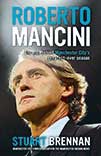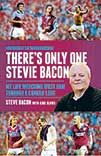{youtube}Kur5sS3EWQs{/youtube}
Author Archive
Day six of the WSC advent calendar and we’ve got snowballs for you. When Division Three’s Sheffield Wednesday hosted top-tier Arsenal in the FA Cup in 1979, the pitch was cleared of snow but the open Kop wasn’t. It gave Owls fans plenty of ammunition to hurl at Arsenal keeper Pat Jennings as the second half began – not behaviour we condone, obviously. The game was drawn 1-1, the reply at Highbury 2-2, the second and third replays at Filbert Street 2-2 and 3-3 before Arsenal finally won 2-0 in the fourth replay.
Skip to 5m20s for snowballs
{youtube}YK0HkGEPmxI{/youtube}
 The man behind Manchester City’s
greatest ever season
The man behind Manchester City’s
greatest ever season
by Stuart Brennan
Andre Deutsch, £16.99
Reviewed by Matthew Barker
From WSC 310 December 2012
Roberto Mancini was a gloriously gifted player. He was also stroppy; prone to outbursts and sulks that frequently alienated him from coaches of club and country and, occasionally, some of his team-mates. Now, as a manager himself, he has to deal with players who can comfortably outdo him on the ego and attitude fronts.
The first 100 pages or so of Stuart Brennan’s book are dedicated to Mancini the footballer, particularly his time at Sampdoria. Mancini’s contention that he was actually a midfield playmaker, rather than an out-and-out striker, caused him problems throughout his playing career. His great vision and unfailing talent for placing the ball where he wanted won him endless plaudits, but fallings out with a succession of Azzurri coaches and a surfeit of Italian attacking talent put the blockers on his international career.
Bar a few stand-out howlers – claiming the Calciopoli scandals took place “six years after” Italia 90, for one – the main problem here is the author’s drawn-out, clumsy theory that Mancini has always sided with the underdog, and that his notorious stubbornness is actually the stuff of an anti-establishment rebel (this despite him being a boyhood Juventus fan).
We are told that his move to Sampdoria in 1982, after a debut season with Bologna, “appealed to his sense of destiny” and that the Genovese club – a “provincial footballing backwater” apparently – provided the perfect platform for someone keen to topple the established Serie A order. And yes, it’s pretty obvious where we’re going with this one.
Less time is spent looking at Mancini’s time in Italy as a coach, which is a pity. The traumas of a first job in charge of Fiorentina, when the club were edging towards bankruptcy and demotion to the old Serie C, are dealt with in a few paragraphs, as is his equally troubled stint at Lazio. Brennan is itching to get to the bit where Mancini takes charge at Inter, so he can triumphantly point out that Nerazzurri are sort of, a bit, kind of like Manchester City. And Milan just like Manchester United. Perfect. Except, of course, they’re not.
The claim that il Mancio was sacked by an “ungrateful” and “impatient” Inter after three post-Calciopoli championship wins is hugely misleading. Most Italian commentators (and did Brennan really not think to speak to one?) believe the coach engineered his move away from the club and that his bluff was called after he reportedly told players he was going to Chelsea following Inter’s 2008 Champions League exit against Liverpool.
Instead of the promised insight and examination, we get a decidedly uncritical portrait; there is little analysis of the handling of Carlos Tévez. The relentless blandness of Mancini’s press conference quotes are interspersed with uninspiring, cut-and-paste retellings of events from the past couple of years, stuff that anyone with a passing interest in British football, never mind Manchester City supporters, surely knows well enough already.
We’re told those City fans are “in delirium”, some lucky ones are even “in ecstasy”, and surely no one can begrudge them that? Brennan sees his subject’s habitual grumpy aloofness as a positive, proof that he’s willing to fight his corner. However, a more searching assessment of Mancini, both as a man and a manager, could have flagged up warning signs of potential troubles ahead.
 by Michael Blackburn
by Michael Blackburn
Grosvenor House, £7.99
Reviewed by Tom Greene
From WSC 310 December 2012
I was 100 pages into reading Agents, Rovers and Cricket Loving Owners when Steve Kean resigned from Blackburn Rovers. The author, Michael Blackburn, pours so much of his heart and soul into describing the pain both Kean and Venky’s have caused the club’s support that my first thought on hearing the news was for him. His book is a history of Venky’s takeover from the perspective of an exasperated fan living through it.
The story is certainly there to be told – Rovers have gone from one of the best run clubs in the League, operating successfully on very little external funding in one of the poorest parts of the UK, to an utter shambles. The catalogue of mismanagement, PR embarrassments and total lack of direction described in the book continues to this day. At the time of writing, despite Kean’s resignation almost a month ago, there is still no new manager in place. When Venky’s took over Kean was Sam Allardyce’s first-team coach. Currently in charge is Kean’s assistant, Eric Black: anyone is in with a chance of the manager’s job at Ewood Park.
The book is a chronological story from the day the Venky’s took over in November 2010 to eventual relegation last May. The structure is both a strength and weakness. On the positive side, no detail of the fans’ experience has gone undocumented and almost every game of Kean’s reign is described in painstaking detail. However, his poor team selection, delusional post-match analysis and never-ending optimism about his own and the team’s position is not enough to engage the reader throughout.
My favourite sections of the book are where we get pure unadulterated Kean. Although the author is scornful of Kean’s playing and managerial experience, this was not what made him a disastrous manager. His Comical Ali-style post-match debriefs are catalogued with some verve, although I was disappointed that a personal favourite – where Kean blamed a David Dunn shot hitting the post on a lack of dew on the grass – was not included in the author’s top ten. However, because we do not hear from Venky’s or their ex-manager directly (no doubt not for want of trying by the author) we are left with the same longing for the true story as Rovers fans will have felt living through it.
This book will not shed any new light on the Venky’s debacle for anybody who has followed the era closely. However, you could not get a more comprehensive account of what it has felt like to be a Rovers fan over the last two years. For those fans of Premier League teams not content with mid- to lower-table obscurity, read this book and it will show you that things could be worse. A lot worse.
 My life watching
West Ham through
a camera lens
My life watching
West Ham through
a camera lens
by Steve Bacon & Kirk Blows
Biteback, £15.99
Reviewed by Neil Fairchild
From WSC 310 December 2012
When Steve Bacon was appointed West Ham club photographer in 1980, John Lyall was only the fifth West Ham manager of the 20th century. In the 23 years since Lyall’s departure, there have been nine different permanent managers and almost as many promotions and relegations. For Hammers fans the familiar rotund figure of Bacon waddling across the pitch on matchdays has become a reassuring constant in an uncertain world.
Until Alan Pardew arrived in 2003 Bacon would travel to away matches on the team coach. He would even be present in the dressing room during team talks. There’s Only One Stevie Bacon is a behind-the-scenes glimpse at the dysfunctional world of West Ham over three decades, with a chapter dedicated to the tenure of each manager from Lyall to Gianfranco Zola.
Although Bacon’s subjectivity gives the book a partial and at times spiteful feel – Paul Kitson is a “weasel”, Brian Kidd a “horrible little shit” – his refusal to pander to fans’ preconceptions makes for a refreshing viewpoint. Ron Greenwood is an “awkward bugger” and Pardew, who was the last manager to have his name sung by West Ham fans, is repeatedly dismissed as arrogant and mocked for his use of psychology and motivational techniques. Lou Macari, loved by neither fans nor players, is portrayed in a surprisingly compassionate light. Others are depicted in exactly the way you would expect: old-fashioned Billy Bonds, for example, struggles with the modern world. Following rumours about the close relationship between Ian Bishop and Trevor Morley, Bonds calls both players into his office and asks: “Well, are you or ain’t you?” It turns out they ain’t.
Kirk Blows, author of various books on West Ham, has been enlisted to bring a sense of cohesion to these anecdotes. Blows appears to have viewed his role as that of articulating Bacon’s thoughts rather than challenging them. At times some editing would have been kind. Bacon’s bafflement at the poor quality of televisions in a department store in 1980s communist Romania (“the arsehole of the universe” as he charmingly calls it) would have been a useful omission.
Bacon is the first to admit that he is no football expert and this book sheds little light on why the FA Cup that was won just before his arrival was the club’s last piece of major silverware. Nevertheless there are plenty of interesting and funny tales: the team coach stopping on the way to a match at Stoke to allow the kit manager to put a bet on for Macari; a naked John Moncur jumping out of a locker during one of Harry Redknapp’s team talks; a frightened Paolo di Canio telling a stewardess “I don’t want to die” before getting off a plane that is about to take off.
Far too often the tone of the book is brought down by stories that would be better left in the pub. His fondness of Mark Ward’s wife’s “big boobs” and a players’ masturbation competition on the team coach (yes, really) are two examples. Then again, given the niche target market for this book, perhaps Bacon simply has a good understanding of his audience.